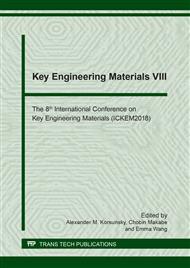p.536
p.542
p.547
p.554
p.560
p.567
p.576
p.582
p.589
Material Properties of Natural Rubber Solid Tires for Finite Element Analysis
Abstract:
The three natural rubber compounds of solid tires producing were performed the mechanical property test. The constitutive model of each material tire layer was determined by the curve fitting method of the true stress-strain characteristic results. The Ogden constitutive model was the most suitable material model for all layers of solid tires. It had the precise R2 result comprising of 0.990, 0.988 and 0.989 for the internal, middle and tread layer of solid tires, respectively. Subsequently, the material model was implemented for the finite element method (FEM) to test the rubber specimens. The FEM obtained an average error of 7.84%. Finally, the compression load test on solid tires was performed both FEM and physical experiment. The solid tire model with the Ogden constitutive model had a good agreement with the experimental data and obtained an average difference of 2.27 mm for the vertical deformation under compression test.
Info:
Periodical:
Pages:
560-564
Citation:
Online since:
August 2018
Authors:
Keywords:
Price:
Сopyright:
© 2018 Trans Tech Publications Ltd. All Rights Reserved
Share:
Citation:


